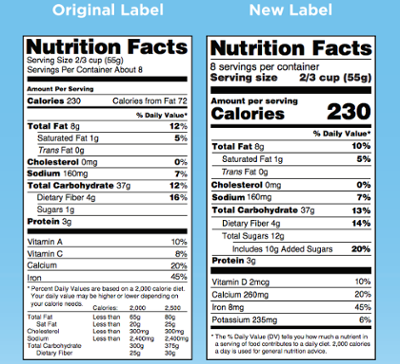Reading the nutrition labels on your foods is about to get more informative. As of January 1st, 2020 the Food and Drug Administration is requiring updated information and a refreshed label design to make it easier for consumers to identify food choices that support a healthful diet. So, what are the changes and how can they help you?

Servings
We've all probably finished a bag of chips thinking it was a single serving - only to discover it was actually three, meaning everything from calories to sodium consumed was triple what we thought. On the new labels, the number of servings will be more prominent with a larger and bolder font. Additionally, serving size will also be modified to better represent the portion consumed by most Americans. For instance, a single serving of ice cream will be modified from 1/2 cup to 2/3 cup.
Calories
This is the most obvious change you will see. The calorie count of a single serving will now be the most prominent information on the label.
Fats
Labels are no longer required to list the percentage of calories from fat. This is due to the fact that it is now understood that the type of fat consumed is more impactful on health than the amount of total fat consumed. Labels will still list "total fat," "saturated fat" and "trans fat" amounts. Aim to avoid trans fats and consume less saturated fat than unsaturated fats.
Added Sugars
Formerly Total Sugars was the only labeling of sugar required. The new label will require manufacturers to include how much added sugar is in a food. Healthful foods such as low fat dairy and fresh fruit contain natural sugars and are part of a balanced diet. Added sugars include any sweeteners added during processing or packaging, and should be limited to 10% of your daily caloric intake.
Nutrients
The nutrients listed on the label will be modified to better represent deficiencies within the American diet. Vitamin D and potassium will be listed, while vitamins A and C will be removed since deficiencies of these nutrients have become rare. In addition to the percentage of the daily value, manufacturers will be required to list the actual milligrams or micrograms contained within the serving.
Footnote
The footnote is changing to better explain the term "daily value." It will now read, "*The % Daily Value tells you how much a nutrient in a serving of food contributes to a daily diet. 2,000 calories a day is used for general nutrition advice."